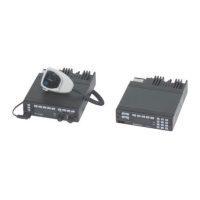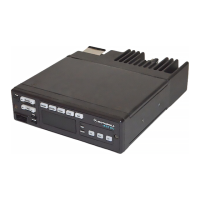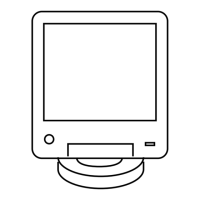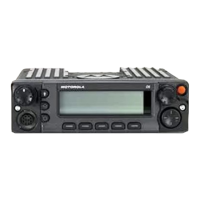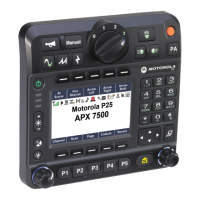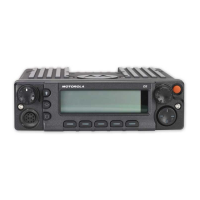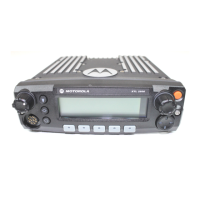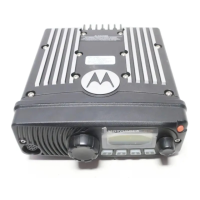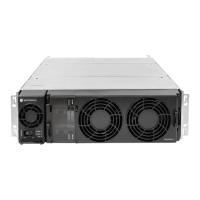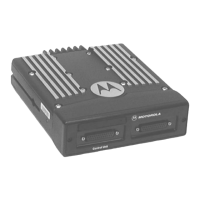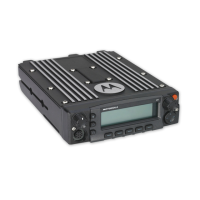6881076C20-E February 3, 2003
Basic Theory of Operation: VOCON (Vocoder/Controller) Board 3-7
The regulator and power control circuits include an unswitched +5V discrete circuit and the regulator/
power control IC, which produces both switched +5V and 9.6V. The unswitched +5V source is used
as a reference for its switched +5V source. Filtered unswitched +5V is used for the microcontrol
circuits. Switched +5V and 9.6V are controlled by a digital transistor from the serial input/output IC.
The power control circuitry receives power set and limit inputs from the digital-to-analog IC, and
feedback from the RF power amplifier. Based on those inputs, the power control circuitry produces a
control voltage to maintain a constant RF power level to the antenna.
The reset circuits consist of the power-on reset, high/low battery voltage reset, and the external bus
system reset. The reset circuits allow the microcomputer to recover from an unstable situation; for
example, no battery on the radio, battery voltage too high or too low, and remote devices on the
external bus not communicating. Communication in RS-232 protocol is provided by an IC which
interfaces to the rear accessory connector (J2).
3.11 VOCON (Vocoder/Controller) Board
The VOCON board, located on the top side of the radio chassis, contains a microcontrol unit (MCU)
with its flash memory, DSP, and DSP-support ICs. The VOCON board controls receive/transmit
frequencies, the display, and various radio functions, using either direct logic control or serial
communication to external devices. The connector J801 provides interface between the encryption
module and the VOCON board for encrypting voice messages.
3.11.1 ASTRO Digital Spectra
The VOCON board executes a stored program located in the FLASH ROM. Data is transferred to
and from memory by the microcontrol unit data bus. The memory location from which data is read, or
to which data is written, is selected by the address lines.
The support-logic IC acts as an extension of the microcontrol unit by providing logic functions such
as lower address latch, reset, memory address decoding, and additional control lines for the radio.
The VOCON board controls a crystal-pull circuit to adjust the crystal oscillator frequency on the
microcontrol unit, so that the E-clock harmonics do not cause interference with the receive channel.
The vocoder circuitry on the VOCON board is powered by a switched +5 volt regulator located on the
command board. This voltage is removed from the board when the radio is turned off by the control
head switch.
The DSP IC performs signaling, voice encoding/decoding, audio filtering, and volume control
functions. This IC performs Private-Line/Digital Private-Line (PL/DPL) encode and alert-tone
generation. The DSP IC transmits pre-emphasize analog signals and applies a low-pass (splatter)
filter to all transmitted signals. It requires a 33MHz crystal to function. An 8 kHz interrupt signal
generated by the DSP-support IC is also required for functionality. This device is programmed using
parallel programming from the microcontrol unit and the DSP-support IC.
The DSP-support IC performs analog-to-digital and digital-to-analog conversions on audio signals. It
contains attenuators for volume, squelch, deviation, and compensation, and it executes receiver
filtering and discrimination. The IC requires a 2.4MHz clock to function (generated by the digital
back-end IC) and is programmed by the microcontrol unit’s SPI bus.
3.11.2 ASTRO Digital Spectra Plus
The VOCON board, located on the top-side of the chassis, contains a Dual-Core processor, which, in
turn, contains a DSP Core, an MCORE Microcontroller Core, and custom peripherals. The board
also contains memory ICs and DSP support ICs.
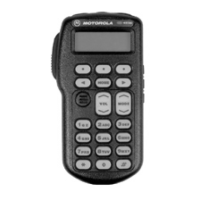
